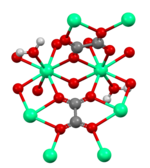
Back Kalsiumoksalaat Afrikaans أكسالات الكالسيوم Arabic کلسیوم اقزالات AZB ক্যালসিয়াম অক্সালেট Bengali/Bangla Oxalat de calci Catalan Šťavelan vápenatý Czech Calciumoxalat German Kalcia oksalato Esperanto Oxalato de calcio Spanish کلسیم اگزالات Persian

| |
 | |
| Names | |
|---|---|
| Preferred IUPAC name
Calcium oxalate | |
| Systematic IUPAC name
Calcium ethanedioate | |
| Other names
Oxalate of lime
| |
| Identifiers | |
| |
3D model (JSmol)
|
|
| ChEBI | |
| ChEMBL | |
| ChemSpider | |
| ECHA InfoCard | 100.008.419 |
| EC Number |
|
| KEGG | |
PubChem CID
|
|
| UNII |
|
CompTox Dashboard (EPA)
|
|
| |
| |
| Properties | |
| CaC2O4 | |
| Molar mass | 128.096 g·mol−1 |
| Appearance | colourless or white crystals (anhydrous and hydrated forms) |
| Density | 2.20 g/cm3, monohydrate[1] |
| Melting point | 200 °C (392 °F; 473 K) decomposes (monohydrate) |
| 0.61 mg/(100 g) H2O (20 °C)[2] | |
Solubility product (Ksp)
|
2.7 × 10−9 for CaC2O4[3] |
| Hazards | |
| Occupational safety and health (OHS/OSH): | |
Main hazards
|
Harmful, Irritant |
| GHS labelling: | |

| |
| Warning | |
| H302, H312 | |
| P280 | |
| NFPA 704 (fire diamond) | |
| Safety data sheet (SDS) | External SDS |
| Related compounds | |
Other anions
|
Calcium carbonate Calcium acetate Calcium formate |
Other cations
|
Sodium oxalate Beryllium oxalate Magnesium oxalate Strontium oxalate Barium oxalate Radium oxalate Iron(II) oxalate Iron(III) oxalate |
Related compounds
|
Oxalic acid |
Except where otherwise noted, data are given for materials in their standard state (at 25 °C [77 °F], 100 kPa).
| |

Calcium oxalate (in archaic terminology, oxalate of lime) is a calcium salt of oxalic acid with the chemical formula CaC2O4 or Ca(COO)2. It forms hydrates CaC2O4·nH2O, where n varies from 1 to 3. Anhydrous and all hydrated forms are colorless or white. The monohydrate CaC2O4·H2O occurs naturally as the mineral whewellite, forming envelope-shaped crystals, known in plants as raphides. The two rarer hydrates are dihydrate CaC2O4·2H2O, which occurs naturally as the mineral weddellite, and trihydrate CaC2O4·3H2O, which occurs naturally as the mineral caoxite, are also recognized. Some foods have high quantities of calcium oxalates and can produce sores and numbing on ingestion and may even be fatal. Cultural groups with diets that depend highly on fruits and vegetables high in calcium oxalate, such as those in Micronesia, reduce the level of it by boiling and cooking them.[4][5] They are a constituent in 76% of human kidney stones.[6] Calcium oxalate is also found in beerstone, a scale that forms on containers used in breweries.
- ^ Cite error: The named reference
Actawas invoked but never defined (see the help page). - ^ Haynes, W., ed. (2015–2016). Handbook of Chemistry and Physics (96th ed.). CRC Press. p. 4-55.
- ^ Euler. "Ksp Table: Solubility product constants near 25 °C". chm.uri.edu. Retrieved 10 June 2021.
- ^ Arnold, Michael A. (2014). "Pandanus tectorius S. Parkinson" (PDF). Aggie Horticulture. Texas A&M University. Archived from the original (PDF) on 31 August 2021. Retrieved 30 September 2020.
- ^ WebMD Editorial. "Foods High in Oxalates". WebMD. Retrieved 30 January 2022.
- ^ Singh, Prince; Enders, Felicity T.; Vaughan, Lisa E.; Bergstralh, Eric J.; Knoedler, John J.; Krambeck, Amy E.; Lieske, John C.; Rule, Andrew D. (October 2015). "Stone Composition Among First-Time Symptomatic Kidney Stone Formers in the Community". Mayo Clinic Proceedings. 90 (10): 1356–1365. doi:10.1016/j.mayocp.2015.07.016. PMC 4593754. PMID 26349951.
© MMXXIII Rich X Search. We shall prevail. All rights reserved. Rich X Search
